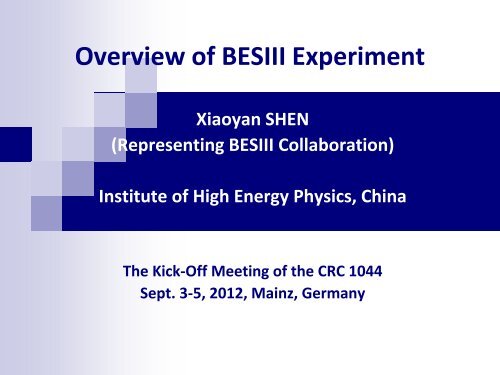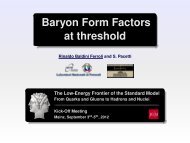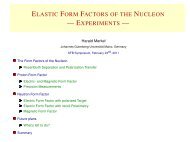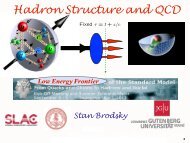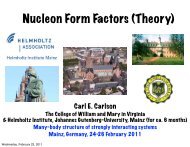Xiaoyan Shen (IHEP, Chinese Academy of Sciences, China)
Xiaoyan Shen (IHEP, Chinese Academy of Sciences, China)
Xiaoyan Shen (IHEP, Chinese Academy of Sciences, China)
Create successful ePaper yourself
Turn your PDF publications into a flip-book with our unique Google optimized e-Paper software.
Overview <strong>of</strong> BESIII Experiment<strong>Xiaoyan</strong> SHEN(Representing BESIII Collaboration)Institute <strong>of</strong> High Energy Physics, <strong>China</strong>The Kick-Off Meeting <strong>of</strong> the CRC 1044Sept. 3-5, 2012, Mainz, Germany
(BEPC/BES)beam energy: 1.0 – 2.3 GeVBESPhysics goal1-2.3GeV e+ e- collisions producecharmonium states (J/,(2S), cJ and (3770) etc.), charmmesons and lepton.4
BESIII detectorTOF:80 ps barrel110 ps end cap• Comparable capabilities to CLEO-c, plus muon ID• The big advantage: BEPCII is a two-ring machine designed for charm– Design (achieved) luminosity at ψ(3770): 1 (0.65) x 10 337
The BESIII CollaborationUS (6)Univ. <strong>of</strong> HawaiiUniv. <strong>of</strong> WashingtonCarnegie Mellon Univ.Univ. <strong>of</strong> MinnesotaUniv. <strong>of</strong> RochesterUniv. <strong>of</strong> IndianaEurope (12)Germany: Univ. <strong>of</strong> Bochum,Univ. <strong>of</strong> Giessen, GSIUniv. <strong>of</strong> Johannes GutenbergHelmholtz Ins. In MainzRussia: JINR Dubna; BINP NovosibirskItaly: Univ. <strong>of</strong> Torino,Frascati LabNetherland:KVI/Univ. <strong>of</strong> GroningenSweden: Uppsala Univ.Turkey: Turkey Accelerator CenterPakistan (2)Univ. <strong>of</strong> PunjabCOMSAT CIIT~300 members52 institutions from 11 countries<strong>China</strong>(30)Korea (1)Seoul Nat. Univ.<strong>IHEP</strong>, CCAST, GUCAS, Shandong Univ.,Univ. <strong>of</strong> Sci. and Tech. <strong>of</strong> <strong>China</strong>Zhejiang Univ., Huangshan Coll.Huazhong Normal Univ., Wuhan Univ.Zhengzhou Univ., Henan Normal Univ.Peking Univ., Tsinghua Univ. ,Zhongshan Univ.,Nankai Univ.Shanxi Univ., Sichuan Univ., Univ. <strong>of</strong> South <strong>China</strong>Hunan Univ., Liaoning Univ.Nanjing Univ., Nanjing Normal Univ.Guangxi Normal Univ., Guangxi Univ.Suzhou Univ., Hangzhou Normal Univ.Lanzhou Univ., Henan Sci. and Tech. Univ.Hong Kong Univ., Hong Kong <strong>Chinese</strong> Univ.Japan (1)Tokyo Univ.8
Physics Topics at BES Study <strong>of</strong> Light hadron spectroscopy search for non-qq or non-qqq states meson spectroscopy baryon spectroscopyarXiv: 0809.1869 Study <strong>of</strong> the production and decay mechanisms <strong>of</strong>charmonium states: J/, (2S), C (1S), C{0,1,2} , C (2S), h C ( 1 P 1 ), (3770), etc.New Charmonium states above open charm threshold. Precise measurement <strong>of</strong> R values, mass, ... Precise measurement <strong>of</strong> CKM matrix Search for DDbar mixing, CP violation, etc.9
Charmonium physics• Clean environment,abundantaryproduced.• A transition regionfrom pQCD to nonpQCD.• Study production,decays, transition.• New states aboveopen charmthreshold.Current charmonium spectrumX(3872)??
DD pairs at (3770) and D s(*)+D s(*)-pairs at(4040) or (4160) for high precision charm physics.BESIIIone yearLumi. 5 fb -1at (3770)peakVcd/Vcd 7% 1.2% Vcs/Vcs 1.1% 16%DVud/Vud 0.1%nenpl lnpVtd/Vtd 3.5%Vtd/Vtd 36%B d BddVus/Vus 1%lnpKDllVub/Vub 15% 3.5%BlnpVcb/Vcb 5% 2.1%n nBnKVts/Vts 3.5%Vts/Vts 39% Vtb/Vtb 29%WtB s B s sBblDBESIIIBESIII + LatticeQCD +B factoriesBESIII + LQCD+B-factories+pp/ppMeasure the CKM matrix elements and associated phasesin order to over-constrain the unitary triangles.
R measurement mass measurementR : one <strong>of</strong> the most important andfundamental quantities inparticle physics.-ehadronsq -se + qR e -m -se +m +lowestorder= SQ f2flavorcolorThe precision <strong>of</strong> R reaches 1-2%at BESIII.With the new energy measurementsystem, the uncertainty on beamenergy can reach 90 keV.13
BESIII data sets and future plan• July 19, 2008: first e + e - collision event in BESIII• Nov. 2008: ~ 14M (2S) events for detector calibration• 2009: 106M (2S) 4*CLEOc225M J/ 4*BESII• 2010: 900 pb -1 (3770)• 2011: 1800 pb -1 (3770) 3.5*CLEOc470 pb -1 @ 4.01 GeV• 2012: tau mass, (2S): 0.4 billion, J/: 1 billion, R scanTentative future run plans:2013: E CM =4260 and 4360 MeV for “XYZ” studies, R scan2014: E CM =4170 MeV for Ds (~2.4 fb -1 )TBD Additional ψ(3770) data14
• Charmonium physicsSelected results from BESIII Charmonium spectroscopy Transitions and decays• Light hadron spectroscopy Meson & baryon spectroscopy Search for unconventional hadrons –glueballs, hybrids, multi-quark states• Charm physics200(10 6 ) J/’150100500225M J/106M ’ Decay constant f D CKM matrix elements: Vcd, Vcs0.9 or 2.9 fb -1 (3770)
Charmonium states’, h c ( 1 P 1 ), c (1S), c (2S)16
h c ( 1 P 1 ) state• Spin singlet P wave (S=0, L=1)• Potential model:if non-vanishing spin-spin interaction:DM hf (1P) = M(h c ) - ≠0where = [(M( c0 )+3M( c1 )+5M( c2 )]/9Theoretical prediction:BF((2S)p 0 h c ) = (0.4-1.3)× 10 -4BF(h c c ) =48% (NRQCD)BF(h c c ) =88% (PQCD) Kuang, PR D65 094024 (2002)BF(h c c ) =38% Godfrey and Rosner, PR D66 014012(2002)
h c ( 1 P 1 ) state (cont.)• The charmonium family has been studied for many years,the knowledge on h c ( 1 P 1 ) is limited.• E835 made scans <strong>of</strong> p energy for the reactionpp h c c , c , 3s levelThe results from the year 1997 scan and the year 2000 scanwere combined to obtain M(hc)=3525.8±0.2±0.2 MeV.No evidence was found for hc in the previously reported reactionpp → hc → π 0 J/ψ (E760, 1992)• The h c ( 1 P 1 ) state was observed by CLEO_c in 2005.• For (2S) , only observed in (2S) p 0 h cThe main decay mode <strong>of</strong> h c : E1 transition h c c
h c at CLEOc (with whole data set)The absolute branching fractionsB(’p 0 h c ) and B(h c c ) notmeasured.
h c study at BESIII• Inclusive analysis <strong>of</strong> (2S) p 0 h cidentify h c in the inclusive recoiling mass spectrum<strong>of</strong> p 0 .• E1-tagged analysis <strong>of</strong> (2S) p 0 h c, h c ctag E1 photon (~503 MeV) in h c ch c significance improved in inclusive p 0 spectrum• Exclusive analysis <strong>of</strong> (2S) p 0 h c, h c cfully reconstruct the exclusive c decays• h c hadronic decays
Observation <strong>of</strong> h c : Inclusive (2S)p 0 h cbackgroundsubtracted• Select inclusive p 0• A fit <strong>of</strong> D-Gaussian signal + 4 th Poly. bkg• Combined inclusive and E1-photon-tagged spectrumBr((2S)p 0 h c ) = (8.4 ± 1.3 ± 1.0) ×10 -4 (First measurement)Br(h c c ) = (54.3 ± 6.7 ± 5.2) % (First measurement)21
Observation <strong>of</strong> h c : E1-tagged (2S)p 0 h c ,h c cBESIIIPRL 104, 132002 (2010)backgroundsubtracted• Select E1-photon to tag h c• A fit <strong>of</strong> D-Gaussian signal+ sideband bkg. yields:M(h c ) = 3525.40 ± 0.13 ± 0.18 MeV/c 2(h c ) = 0.73 ± 0.45 ± 0.28 MeV/c 2 (< 1.44 MeV/c 2 @ 90% CL)(First measurement)Br(ψ(2S)π 0 h c )×Br(h c c ) = (4.58 ± 0.40 ± 0.50) ×10 -4
’p 0 h c , h c c , c exclusive decaysBESIII PreliminarySummed distribution832± 35 evts.Simultaneous fit to p 0 recoiling mass 2 /d.o.f. = 32/46Mass = 3525.31±0.11±0.15 MeV/c 2Width = 0.70±0.28±0.25 MeV/c 2Evts: 832 ± 35BESIII: PRL 104 132002 (2010)CLEOc: PRL 101 182003 (2008)Consistent with BESIII inclusive resultsMass = 3525.40± 0.13± 0.18 MeV/c 2Width = 0.73± 0.45± 0.28 MeVCLEOc exclusive resultsMass =3525.21±0.27±0.14 MeV/c 2evts. =136± 1423
h c parametersBESIII: PRL 104 132002 (2010) CLEOc: PRL 101 182003 (2008)Mass : 3525.40±0.13±0.18 MeV/c 2 Mass: 3525.28±0.19±0.12 MeVWidth = 0.73±0.45±0.28 MeV
c (1S)• The lowest lying S-wave spin singlet charmonium, discovered in1980 by MarkII. Properties not well known.• J/ radiative transition: M ~ 2978.0MeV/c 2 , ~ 10MeV process:M = 2983.1±1.0 MeV/c 2 , = 31.3±1.9 MeV• CLEOc found the distortion <strong>of</strong> the c line shape in ’ decays.cc• hyperfine splitting M(J/)-M( c (1S)) is the important exp.input to test LQCD, but is dominated by error on M( c (1S)).Mass, pp, B decays(1S, 2S) cwidthC.L.=0.0014C.L.
c lineshape from p 0 h c , h c cSum <strong>of</strong> 16 <strong>of</strong> C decay modesBackgroundsubtractedThe C lineshape is not distorted in the h c CSymmetriclineshapein productionAsymmetriclineshapein J/ decay26
C resonance parameters from C at BESIIIPossible interference has been taken into accountPRL 108 (2012) 222002KsKp KKp 0 ppKsK3p 2K2pp 0 3(pp)Relative phase values from each modeare consistent within 3s. use a common phase value in thesimultaneous fit.mass: 2984.30.6 stat 0.6 sys MeV/c 2width: 32.01.2 stat 1.0 sys MeV: 2.400.07 stat 0.08 sys rad (constructive)or 4.190.03 stat 0.09 sys rad (destructive) 27
Comparison <strong>of</strong> the mass and width for c (1S)Hyperfine splitting: M(1S) = 112.6 ± 0.8 MeVLQCD McNeileQWG 2011Better agreement withLQCD calculations28
• Crystal Ball’s “first observation” <strong>of</strong> ' X never been confirmedPRL 48 70 (1982) c (2S)• Observed in different production mechanisms• BK c (2S)• c (2S)KKp• double charmonium productionBelle: PRL 89 102001 (2002), NPPS.184 220 (2008),PRL 98 082001(2007)CLEOc: PRL 92 142001 (2004)BaBar: PRL 92 142002 (2004); PR D72 031101(2005),PR D84 012004 (2011)• M1 transition ’ c (2S)CLEOc found no signals in 25M ’.BF(’ c (2S)) < 7.6×10 -4 CLEOc: PRD 81 052002 (2010)Experimental challenge : detect photons <strong>of</strong> 50 MeV29
Observation <strong>of</strong> c (2S) in c (2S), c (2S)KKp at BESIIIPotential model predicts: (0.1~ 6.2)10 -4 PRL 89 162002 (2002)CLEOc:
Search for c (2S)VV @BESIIIPhys. Rev. D 84, 091102 (2011)Test for the “Intermediate charmed meson loops” 0 0 K* 0 K* 0 BF(’ c ’VV)(10 -7 )BF( c ’VV)(10 -3 )No signals observed in c (2S), K* 0 K* 0 bar, ;more stringent UL’s are set.Theory BF( c ’VV)(10 -3 ) 0 0
Summary for c / c (2S)’’’[1] NPPS 184 220(2008); [2] PRL 92 142001; [3] PoS ICHEP2010:162, 2010MMhfhf( nS) M ( n( nL) M ( nHyperfine splitting: M(1S) = 112.5 0.8 MeV;M(2S) = 47.6 1.7 MeV331S ) M ( n S1L) M ( n10) L) 0,32p( ms9q)( (0) / mq)2, L=0M(1S) 118 MeVM(2S) 68 MeV32
PRL105, 261801(2010)Some surprises34Q. Zhao, PLB697(2011)52
• Confirmed by CLEOc and BESIIICLEOc PRD 82, 092002 (2010)' ppJ/,J/ψ γpp‣ fit with one resonance as BES did:BESIII CPC 34, 421 (2010)ψ' π-π J/ψ/J/ψ γppBESIII:J/ψγppM=1861 +6 -13 +7 -26 MeV/c 2 < 38 MeV/c 2 (90% CL)
No significant narrow threshold enhancement observed here:(1S) pp@CLEOJ / pp@BESIIPRD 73 (2006) 032001EPJC 53 (2008) 15ψ γpp@BESIIψ γpp@BESIII@CLEOcPRD 82, 092002 (2010)PRL 99 (2007) 011802M pp (GeV)PRL 108, 112003 (2012)
PWA <strong>of</strong> J/pp @ BESIIIPRL 108, 112003 (2012)f 0 (2100) / f 2 (1910) fixed to PDG.Sig. <strong>of</strong> X(ppbar) >>30sJPC 0M 1832105(stat.) 13 39(stat.)18171013Br(J / X)Br(X(syst.)19(model)MeV/ c(syst.) 4(model) MeV/ cpp) (9.00.41.1(stat.)21.55.02( 60MeV/ c(syst.) 2.3(model)) 10Different FSI models Model dependent uncertainty2@90C.L.)539
PWA <strong>of</strong> ’pp @ BESIIIPhys. Rev. Lett. 108, 112003 (2012)Suppressed compared with 12% rule!
X(1835) in ’p + p -J/pp @BESIPRL 95,262001(2005)Statistical Significance ~ 6 sStatistical Significance ~ 5.1 spM=1833.7±6.1(stat)±2.7(syst)MeV=67.7±20.3(stat)±7.7(syst)MeVTheoretical interpretation:‣ pp̅ bound state, η excitation ….‣ Are X(pp̅ ) and X(1835) from the same source?
Why are X(2120) and X(2370) interesting?First time in J/ radiative decaysresonant structures are observed inthe 2.4 GeV/c 2 region.PRD73,014516(2006) Y.Chen et alPRD82,074026,2010J.F. Liu, G.J. Ding and M.L.YanPRD83:114007,2011J.S. Yu, Z.-F. Sun, X. Liu, Q. zhaoand more…it is interesting since:• LQCD predicts the lowest lying0 -+ glueball: around 2.4 GeV/c 2 .• J/-->ππ' decay is a goodchannel for finding 0 -+ glueballs.Nature <strong>of</strong> X(2120)/X(2370)pseudoscalar glueball ?/ excited states?……44
Observation <strong>of</strong> X(1870)BESIII 225M J/f 1 (1285)X(1870)(1405)Significance: 7.2 sJ/X, Xp p The f 1 (1285), (1405)and X(1870) primarilydecay via a 0 (980)p ±Is X(1870) a newresonance, or 2 (1870) or X(1835)?Phys. Rev. Lett.107, 182001 (2011)45
Study <strong>of</strong> J/3pPRL 108 (2012) 182001First observed: (1405)f 0 (980)p 0 (large isospin breaking)f 1 /3.7s(1405)f 0 (980)p - p +f 1 /1.2s(1405)f 0 (980)p 0 p 0Very narrow f 0 (980) – much narrower than PDG value!f 0 (980)p + p - f 0 (980)p 0 p 0M = 989.9 ± 0.4 MeV = 9.5 ± 1.1 MeVM = 987.0 ± 1.4 MeV = 4.6 ± 5.1 MeV46
Isospin violation: ’3p PRL 108 (2012) 182001J/’p p p 0 J/’p 0 p 0 p 0BR( pBR( p 0p p )p )0 0 0BR( p p p )0 0BR( p p ) 0.9% 1.6%
Large isospin breaking: (1405)f 0 (980)p 0PRL 108 (2012) 182001In general, magnitude <strong>of</strong> isospin violation in strong decay should beless than 1% or at 0.1% level. For example:0BR( ' p J / )BR( ' J / )0.2 102| P| Pp||33, 0BR( ' p p p ) BR( ' p p )0.9%However:0BR( (1405) f0(980)p ) (17.9 4.2)%BR( (1405) a (980) p)0
Possible explanation: J.J.Wu et al, PRL 108, 081803(2012)Triangle Singularity (TS)a 0 —f 0 mixing0 0Br( c1 f0(980)p p p p )Mixing intensity: af0 0 0Br( a (980) p p p )c10PRD 83 (2010)032003 1% (90%C.L.)The mixing <strong>of</strong> a 0 -f 0 alone is too small to explain the largeisospin violation and narrow f 0 (980).49K*K pair in TS is almost on-shell, together with mixingexplain the narrow f 0 (980), and large isospin violation.
threshold enhancement in J/ J/ , KK(OZI)J/ (DOZI)BESIIM1812192618 MeV/c 105 20 28 MeV/c22J PC favors 0 ++ over 0 -+and 2 ++
J/ @ BESIIIBackgrounds estimatedfrom and sidebandsBackgrounds estimatedfrom inclusive MC -- mainlyfrom K*K
Preliminary PWA results at BESIII:PreliminaryPreliminaryIs X(1810) the f 0 (1710)/f 0 (1790) or new state?
Study <strong>of</strong> system• First observed f 0 (1710) from• J/ radiative decays to by Crystal Ball in 1982.PRL48 (1982) 458.• Crystal Barrel Collaboration (2002)analyzed the three final states p 0 p 0 p 0 , p 0 p 0 and p 0 withK matrix formalism. Found a 2 ++ (1870), but no f 0 (1710).• E835 (2006): ppbar p 0 , found f 0 (1500) and f 0 (1710).• WA102 and GAMS all identified f 0 (1710) in .
J/ @ BESIII• Clear resonances• Very low BG levelM()
Preliminary PWA results <strong>of</strong> J/• f 0 (1710) and f 0 (2100)are dominant scalars• f 0 (1500) exists (8.2 s)• f2’(1525) is thedominant tensor
Charm physics at BESIIIAdvantage <strong>of</strong> open charm at thresholde + e Colliders@threshold:Good for charm flavor physics:• Threshold production: clean• Known initial energy and quantum numbers• Both D and Dbar fully reconstructed (double tag)• Absolute measurements56July 4, 2012Hai-Bo Li (<strong>IHEP</strong>)
CKM matrix:Charm’s roleFlavor physics:• Over-constrain CKMmatrix• Search for new physicsWidths <strong>of</strong> the bands dominatedby the errors <strong>of</strong> f B(Bs) from LQCDIn measuring V td and V ts from B 0 B 0 mixing and BsBs mixing,f B and f Bs are derived from theoretical predictions.• Need inputs from LQCD to precisely measure CKM matrx• Compare experimental f D(Ds) with LQCD to validate LQCD
Pure leptonic decays• All quantities are well measured except f D .• Use world average |V cd | to extract f D• Compare f D with LQCD for the validation <strong>of</strong> LQCD58
Preliminary study <strong>of</strong> D + mn at BESIII• 9 singly D - tag modesK + p - p - K 0 p - K 0 K - K + K - p - K + p - p - p 0p + p - p - K 0 p - p 0 K + p - p - p - p + K 0 p - p - p + N D -( ) ´10 6 in 2.9 fb -1tag = 1.566 ± 0.002-- select exactly onepositive charge trackin D + side-- MuID for m +-- no extra photon
Preliminary study <strong>of</strong> D + mn at BESIII
Main backgrounds for D + mn
The error is still statistical dominated.
Comparison <strong>of</strong> f D with theoriesf D (MeV)
Semi-leptonic decays• For D(Ds) p/K l n• For D(Ds) /K* l n• More factors• No unquenchedLQCD calculationavailableOnly one form factor• Measure CKM elements• Validate LQCD64
Preliminary study <strong>of</strong> D 0 pen and Ken4 tag modes used:Signal selection:65UEmiss|Pmiss| 0
UEmiss|Pmiss| 00.92 fb -1 0.92 fb -1Fit U distribution:
0.92 fb -1
• Points are data with statistical error only• Curves are from Fermilab-MILC (arXiv:11115471)with 1s statistical band0.92 fb -1
Form factor fits0.92 fb -1
Form factor resultsForm factor parametrizationPhys. Lett. B 478 (2000) 418Phys. Lett. B 633 (2006) 61
SummaryBEPCII/BESIII upgrade completed successfully• peak Luminosity <strong>of</strong> 6.5x10 32 achieved.• ~106 M (2S) and ~225 M J/ events obtained in2009.• ~2.9 fb -1 at (3770) so far.• 470 pb -1 data @4.01GeV• 1 billion J/, 0.5 billion ’ data this year.• R scan between 2.4 – 3.6 GeV, tau massmeasurement~500 pb -1 at 4260 MeV and ~500 pb -1 at 4360 MeV,R scan at high mass region in next physics run.71
73’J/
• Select (2S) J/, J/ e + e - and m + m - events sm - low energy gammaeeFirst evidence <strong>of</strong> (2S) J/mmarXiv: 1204.0246 Submitted to PRL• the cJ components: double E1scaling• yields <strong>of</strong> the two-photonevents• continuum(green)+ ’-decayBG(yellow)• Global fit <strong>of</strong> the two-photon process andcascade cJ processes• See clear excess over BG + continuum74July 4, 20123.44
Higher-order multipole in c2 , c2 p + p - ,K + K -Investigate the contribution from high-order multipole amplitudesPRD84, 092006 (2011)75
76Higher-order multipole in c2 , c2 p + p - ,K + K -PRD84, 092006 (2011)
From CKMfitter


